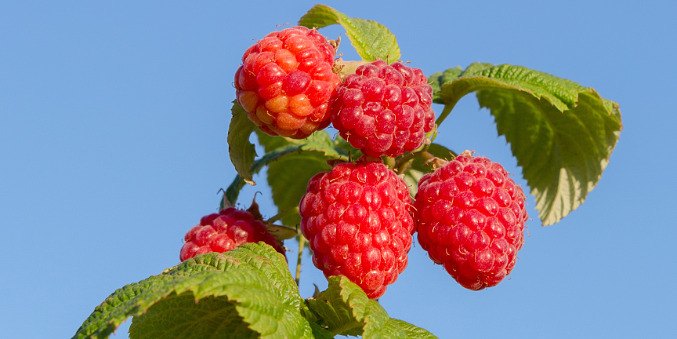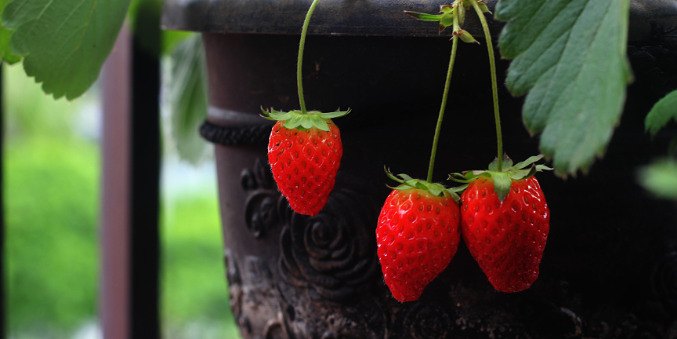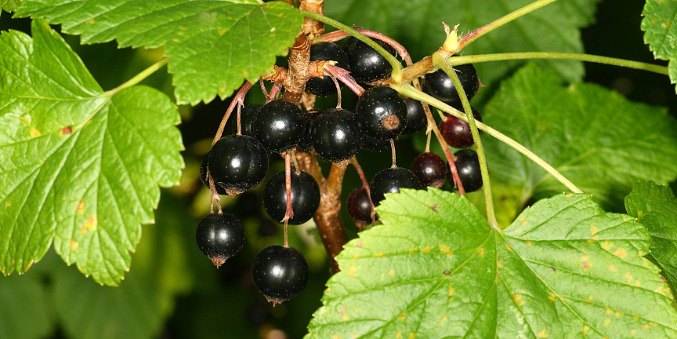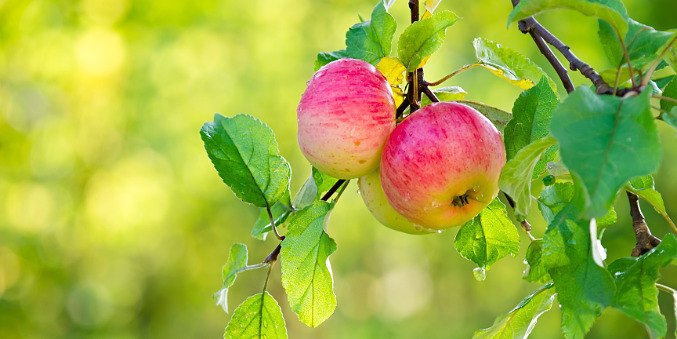
How to grow your own fruit
10 Minute Read
If you’re looking to grow your own fruits, this is the guide for you. Let’s get growing.How to grow your own fruit
There are so many fruits that can be grown in a range of gardens, whether you have a larger space or just have a balcony to work with, there’s plenty to grow – Plus, what’s better than enjoying a delicious, handpicked berry, on a balmy summer’s day? Knowing you’ve grown and nurtured it yourself, probably.Let's get started.
How to grow raspberries

Raspberries are cheap, easy to grow and simply delicious; these berries are categorised as either summer-fruiting or autumn-fruiting. Summer-fruiting raspberries tend to produce fruit once a year and require staking whereas autumn-fruiting raspberries are less vigorous but produce fruit twice a year.
If you really want to enjoy the fruits of your labour, you’ll want one of each type, so that you can enjoy those little red jewels all the way through June and well into October.
If you really want to enjoy the fruits of your labour, you’ll want one of each type, so that you can enjoy those little red jewels all the way through June and well into October.
Where to grow raspberries
Raspberries thrive in full sunlight, so select a location in your garden that receives at least 6-8 hours of direct sunlight each day. Ensure the soil is well-draining and rich in organic matter.
Raspberries thrive in full sunlight, so select a location in your garden that receives at least 6-8 hours of direct sunlight each day. Ensure the soil is well-draining and rich in organic matter.
Soil preparation
Before planting, prepare the soil by removing weeds, rocks, and debris. Test the soil pH and aim for a slightly acidic to neutral range (pH 5.5 to 7.0). If the soil is too alkaline, you can amend it with compost or well-rotted manure.
Planting raspberries
Raspberry plants can be grown from bare-root plants or container-grown plants. Plant them in early spring or late autumn, digging a hole large enough to accommodate the roots comfortably and place the plants about 2-3 feet apart in rows with 6-8 feet of spacing between the rows.
Watering
Raspberries require consistent moisture, especially during the growing season and fruiting period. Keep the soil evenly moist but avoid waterlogged conditions. Drip irrigation systems work well.
Mulching & feeding
Apply a layer of organic mulch, such as straw or wood chips. Mulch helps retain soil moisture, suppresses weed growth, and adds nutrients to the soil as it breaks down. Apply a balanced fertiliser in early spring before new growth begins. You can also side-dress with compost or well-rotted manure during the growing season.
Pruning
Proper pruning is essential for raspberry plants. Summer-bearing varieties produce fruit on canes that grew the previous year, while ever-bearing varieties produce on both previous year's canes and current season's canes. Prune out the old, dead canes and thin the new canes to encourage better fruiting and airflow.
How to grow blueberries

Blueberries come in different varieties, including highbush, low bush, and rabbiteye. Research the best varieties for your preferences and consider factors like flavour and size.
Where to grow blueberries
Blueberries prefer full sunlight but can tolerate some shade. Choose a location with at least 6-8 hours of direct sunlight daily. The soil should be well-draining, loose, and rich in organic matter. Blueberries thrive in acidic soil with a pH between 4.5 and 5.5.
Soil preparation
Test your soil's pH level and amend it if necessary. Mix organic matter, such as compost or pine bark, into the soil to improve its texture and fertility.
Planting blueberries
Blueberries are usually planted as young plants, either bare-root or container-grown. The best time to plant them is in early spring or late fall when the ground is workable. Dig a hole that's about twice the size of the plant's root ball and space multiple plants about 4-6 feet apart.
Mulching & feeding
Apply a layer of organic mulch, like pine straw or wood chips, around the base of the blueberry plants. Mulch helps to retain soil moisture, regulate temperature, and prevent weed growth.
Blueberries have specific nutrient requirements. Apply a balanced, acid-forming fertiliser in early spring, and avoid using fertilisers high in nitrogen, as it can harm the plants. Instead, use a fertiliser formulated for acid-loving plants.
Watering
Blueberries require consistent moisture, especially during the growing season and fruiting period. Keep the soil evenly moist but avoid waterlogged conditions. A drip irrigation system is beneficial for providing regular and deep watering.
Pruning
Pruning is essential for blueberry bushes to maintain their health and productivity. In the first year, remove any flowers that develop to encourage root and plant growth. In subsequent years, prune dead or weak wood, as well as any low-hanging branches that touch the ground.
Protecting against wildlife and cold weather
Birds love blueberries just as much as we do, so consider protecting your plants with bird netting or other deterrents during fruiting season.
In colder climates, provide winter protection for your blueberry plants. Mulch around the base of the plants with straw or leaves to insulate the roots and prevent cold damage.
Harvesting
Blueberries are ready for harvest when they turn deep blue and easily detach from the bush with a gentle pull. Harvest the ripe berries carefully to avoid damaging the plant.
How to grow strawberries

Growing strawberries can be a fun and rewarding experience. These sweet and juicy fruits are easy to grow and can be cultivated in various settings, including gardens, containers, or hanging baskets.
There are three main types of strawberries: June-bearing, everbearing, and day-neutral. June-bearing strawberries produce a single large harvest in late spring or early summer, everbearing produce two harvests (one in spring and one in autumn), while day-neutral strawberries produce fruit throughout the growing season. Choose the variety that suits your desired harvest schedule.
Where to grow strawberries
Strawberries prefer full sunlight, so choose a sunny spot in your garden or on your balcony/patio for container gardening. Ensure the location receives at least 6-8 hours of direct sunlight each day.
Strawberries can be grown from seeds or more commonly from bare-root plants or runners (young plants produced by the parent plant). Plant them in early spring or late summer for the best results. Space the plants about 12-18 inches apart in rows with 2-3 feet of spacing between rows.
Soil Preparation
Strawberries thrive in well-draining, slightly acidic soil with a pH range of 5.5 to 6.5. Prepare the soil by removing weeds, rocks, and debris. Incorporate organic matter like compost or well-rotted manure to improve soil fertility and structure.
Mulching & feeding
Apply a layer of straw or straw-like mulch around the strawberry plants. Mulch helps retain moisture, suppress weeds, and protect the fruits from direct contact with the soil, reducing the risk of rot. Strawberries benefit from a balanced fertiliser, or a fertiliser specifically formulated for strawberries. Apply according to the instructions in the spring and again after the first harvest for everbearing varieties.
Watering
Strawberries need regular watering, especially during dry periods and when the fruits are forming. Keep the soil consistently moist but not waterlogged. A drip irrigation system or soaker hoses are great options to provide even moisture.
Runners and Propagation
Strawberries naturally produce runners, which are long stems that produce new plants. You can let a few runners grow to create new plants, but too many can weaken the parent plant and reduce fruit production. Pinch off excess runners as needed.
How to grow blackberries

Blackberries can be grown in various climates and are perfect for home gardens and larger outdoor areas. We’ve all seen these juicy little berries growing in hedgerows or in green spaces – and many of us have fond memories of foraging and picking blackberries while out in the park or on a walk, so if you’d like to recreate those moments in your own garden, here’s how you can!
There are several types of blackberries, including thorny and thornless varieties. Thornless blackberries are more convenient for picking and maintenance, while thorny varieties may have slightly better fruit quality. Choose the type that best suits your preferences and growing conditions.
Where to grow blackberries
Blackberries require full sunlight to thrive. Select a location in your garden or growing area that receives at least 6-8 hours of direct sunlight each day. Ensure the site has well-draining soil, as blackberries do not like waterlogged conditions.
Plant blackberries in early spring or late fall while the plants are dormant. Space the plants about 3-5 feet apart in rows with 6-8 feet of spacing between rows. Plant them at the same depth they were in the nursery container.
Soil preparation
Prepare the soil before planting by removing weeds, rocks, and debris. Blackberries prefer slightly acidic to neutral soil with a pH range of 6.0 to 7.0. Test your soil and amend it with organic matter like compost or well-rotted manure if needed.
Watering
Blackberries need regular watering, especially during dry periods and when the fruits are forming. Keep the soil consistently moist but not waterlogged. A drip irrigation system or soaker hoses work well for even moisture distribution.
Mulching & feeding
Blackberry plants benefit from fertilisation. Apply a balanced feed in early spring before new growth begins. Additionally, side-dress the plants with compost or well-rotted manure during the growing season to provide nutrients. A layer of organic mulch, such as straw or wood chips, around the base of the blackberry plants is also beneficial. Mulch helps retain soil moisture, suppress weeds, and add nutrients to the soil as it breaks down.
How to grow blackcurrants

These flavourful and nutritious berries are well-suited for various culinary uses, including jams, jellies, desserts, and beverages. Blackcurrants come in different varieties, each with unique flavour profiles and growth characteristics. When choosing a variety, consider factors such as climate suitability, disease resistance, and intended use.
Where to grow blackcurrants
Blackcurrants prefer full to partial sunlight, with at least 6 hours of direct sunlight each day. They also thrive in well-draining soil that is rich in organic matter. Ensure the planting site has good air circulation to reduce the risk of fungal diseases.
Soil preparation
Test your soil to check its pH level. Blackcurrants prefer slightly acidic to neutral soil with a pH range of 6.0 to 7.0. If the soil pH is too high, you can amend it with elemental sulphur to lower the pH. Work in organic matter like compost or well-rotted manure to improve soil fertility and structure.
Planting blackcurrants
Plant blackcurrants in early spring or late fall while the plants are dormant. Space the plants about 4-6 feet apart in rows with 6-8 feet of spacing between rows. Plant them at the same depth they were in the nursery container, making sure the root system is well-covered with soil.
Watering
Water newly planted blackcurrant bushes regularly to help them establish their root systems. Once established, water the plants deeply but infrequently, ensuring the soil stays consistently moist but not waterlogged.
Mulching & feeding
Apply a layer of organic mulch, such as straw or wood chips, around the base of the blackcurrant plants. Mulch helps retain soil moisture, suppress weeds, and maintain a more even soil temperature.
Blackcurrants generally do not require heavy fertilisation. However, you can apply a balanced fertiliser in early spring before new growth starts. Follow the manufacturer's instructions for the appropriate application rates.
Blackcurrants generally do not require heavy fertilisation. However, you can apply a balanced fertiliser in early spring before new growth starts. Follow the manufacturer's instructions for the appropriate application rates.
Pruning
Proper pruning is crucial for blackcurrants to maintain a healthy and productive plant. Prune out any dead or diseased wood during the dormant season. Also, thin out the oldest stems and trim back new growth to encourage better fruiting and airflow.
How to grow passion fruit

These tropical creeping vines produce delicious, exotic fruits that are ideal for making into luxury desserts or enjoying fresh.
Passion fruit vines thrive in warm and sunny climates. Choose a location in your garden or on your balcony/patio that receives full sunlight for at least 6-8 hours a day. There are several passion fruit varieties, including purple and yellow types.
Passion fruit vines thrive in warm and sunny climates. Choose a location in your garden or on your balcony/patio that receives full sunlight for at least 6-8 hours a day. There are several passion fruit varieties, including purple and yellow types.
Soil preparation
Passion fruit prefers well-draining soil with a pH range of 6.5 to 7.5. Test your soil and amend it with organic matter, like compost or well-rotted manure, if needed.
Planting passion fruit
Plant passion fruit seeds or seedlings in the spring or early summer when the soil is warm. If planting seeds, soak them in water for 24 hours before sowing. Plant the seeds or seedlings about 1 inch deep and space them 6-10 feet apart, as passion fruit vines can grow quite large.
Support and training
Passion fruit vines are vigorous climbers that need support to grow properly. Provide a trellis, or fence for the vines to climb on. Train the vines to grow up the support structure as they mature.
Watering
Passion fruit vines require regular watering, especially during dry periods and when the fruits are forming. Keep the soil consistently moist but not waterlogged. Use a drip irrigation system or soaker hoses for efficient watering.
Mulching & feeding
Apply a layer of organic mulch, like straw or wood chips, around the base of the passion fruit plant. Mulch helps retain soil moisture, suppress weeds, and protect the roots from temperature fluctuations. Passion fruit plants benefit from regular feeding. Apply a balanced fertiliser or one high in potassium and phosphorus to promote flowering and fruiting. Follow the manufacturer's instructions for application rates.
Harvesting
Passion fruit is ready for harvest when the fruits are slightly wrinkled. They should easily detach from the vine with a gentle twist. Harvest the ripe fruits regularly to encourage continuous flowering and fruiting.
How to grow figs

Growing figs can be a rewarding experience, as these sweet and nutritious fruits can thrive in both gardens and containers.
There are many fig varieties available, each with unique flavours and growth characteristics. Consider your climate and preferences when selecting a variety. Common types include Black Mission, Brown Turkey, Kadota, and Adriatic.
There are many fig varieties available, each with unique flavours and growth characteristics. Consider your climate and preferences when selecting a variety. Common types include Black Mission, Brown Turkey, Kadota, and Adriatic.
Where to grow figs
Figs prefer full sunlight, so choose a sunny spot in your garden or on your balcony/patio for container gardening. Ensure the location has good air circulation to prevent fungal issues.
Soil Preparation
Fig trees thrive in well-draining soil with a pH range of 6.0 to 6.5. Test your soil and amend it with organic matter like compost or well-rotted manure to improve fertility and drainage. Plant fig trees in the spring or early fall. If you're planting in the ground, dig a hole twice the size of the root ball and place the tree at the same level it was in the nursery container. For container planting, choose a large pot with good drainage holes.
Watering
Water fig trees regularly during the growing season, especially in hot and dry conditions. Once established, fig trees are relatively drought-tolerant, but consistent watering will improve fruit quality.
Mulching & feeding
Apply a layer of organic mulch, such as straw or wood chips, around the base of the fig tree. Mulch helps retain soil moisture, suppress weeds, and regulate soil temperature. Fig trees have modest fertilisation requirements. In the spring, apply a balanced or a fertiliser specifically formulated for fruit trees. Avoid excessive nitrogen, as it can promote excessive leaf growth at the expense of fruit production.
Pollination
Most fig varieties are self-pollinating, so you don't need multiple trees for pollination. However, providing a habitat for pollinators like bees can improve fruit set and yield.
Protection from cold weather
In colder climates, protect your fig tree from winter frost by wrapping it with burlap or covering it with a frost cloth. Container-grown fig trees can be moved indoors to a cool and well-lit location during the winter.
Harvesting figs
Figs are ready for harvest when they are fully ripe and have a rich colour. Ripe figs should be soft to the touch and may even droop slightly. Harvest the fruit gently to avoid bruising.
How to grow apples

Growing apples can be a rewarding endeavour, but it's essential to understand that apple trees require proper care and attention to thrive and produce abundant fruit.
There are numerous apple varieties, each with its unique flavour, texture, and characteristics. Consider your climate, local disease resistance, and intended use (eating, cooking, or cider-making) when selecting apple varieties. Dwarf apple varieties are ideal for container gardening, making apples one of the finest fruit trees to cultivate in pots, as they won't outgrow their containers.
There are numerous apple varieties, each with its unique flavour, texture, and characteristics. Consider your climate, local disease resistance, and intended use (eating, cooking, or cider-making) when selecting apple varieties. Dwarf apple varieties are ideal for container gardening, making apples one of the finest fruit trees to cultivate in pots, as they won't outgrow their containers.
Where to grow apples
Apple trees need full sunlight to produce quality fruit. Select a location in your garden that receives at least 6-8 hours of direct sunlight each day. The site should also be sheltered from strong winds, as they can damage the blossoms and young fruit.
Soil preparation
Apple trees prefer well-draining soil with a pH range of 6.0 to 7.0. Test your soil and amend it with organic matter, like compost or well-rotted manure, if needed. Good soil preparation is crucial for the tree's root development.
Planting apple trees
Plant apple trees in early spring or late fall, while the tree is dormant. Dig a hole that's slightly larger than the tree's root system. Spread the roots out and place the tree at the same level it was in the nursery. Fill the hole with soil, tamp it down gently, and water thoroughly.
Apple trees need adequate space to grow and receive sufficient sunlight and airflow. Standard apple trees should be spaced 25 to 30 feet apart, while dwarf and semi-dwarf varieties can be spaced 8 to 15 feet apart.
Apple trees need adequate space to grow and receive sufficient sunlight and airflow. Standard apple trees should be spaced 25 to 30 feet apart, while dwarf and semi-dwarf varieties can be spaced 8 to 15 feet apart.
Support and training
Young apple trees may need support to grow straight. Stake the tree if necessary and use ties or tree straps to secure it. As the tree grows, you may need to train the branches using pruning and tying techniques to create a strong framework.
Watering
Proper watering is crucial, especially during the tree's early years. Water regularly to keep the soil consistently moist, but not waterlogged. Once the tree is established, it will be more tolerant of drought, but water during dry periods to ensure fruit development.
Pruning
Pruning is vital for apple trees to encourage healthy growth and fruit production. Prune during the dormant season to remove dead, diseased, or crossing branches. Also, thin out branches to improve airflow and sunlight penetration.
Thinning fruit
To promote larger and healthier apples, thin the fruit when they are still small and green. Remove excess fruit to allow the remaining ones to develop fully.
Related products
Comments (0)
Why not be the first to send us your thoughts?




